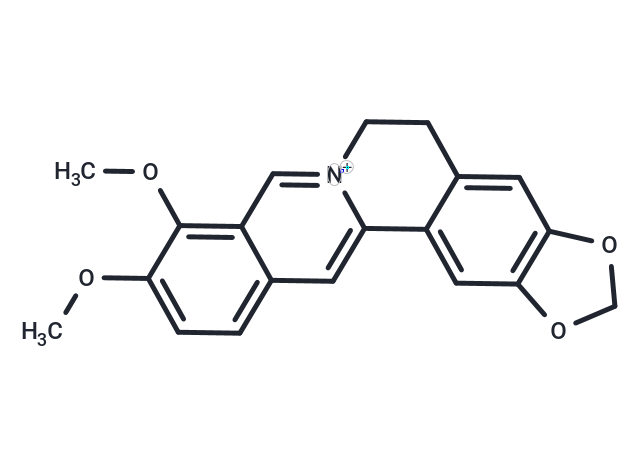- Remove All
 Your shopping cart is currently empty
Your shopping cart is currently empty
Berberine
1. Berberine (Umbellatine) is a potent oral hypoglycemic agent with beneficial effects on lipid metabolism. 2. Berberine may as a broad-spectrum anti-microbial medicine, a complementary therapeutic agent for HIV/AIDS. 3. Berberine seems to act as an herbal antidepressant and a neuroprotector against neurodegenerative disorders. 4. Berberine is used in histology for staining heparin in mast cells. As a natural dye, berberine has a colour index of 7516. 5. Berberine reduces hepatic fat content in rats with nonalcoholic fatty liver disease; also prevents proliferation of hepatic stellate cells (HSCs), which are central for the development of fibrosis during liver injury. 6. Berberine can ameliorate proinflammatory cytokines-induced intestinal epithelial tight junction damage in vitro, and berberine may be one of the targeted therapeutic agents that can restore barrier function in intestinal disease states. 7. Berberine has antineoplastic effects, including breast cancer, leukemia, melanoma, epidermoid carcinoma, hepatoma, pancreatic cancer, oral carcinoma, tongue carcinoma, glioblastoma, prostate carcinoma and gastric carcinoma, etc.

Berberine
| Pack Size | Price | Availability | Quantity |
|---|---|---|---|
| 20 mg | $50 | In Stock | |
| 1 mL x 10 mM (in DMSO) | $50 | In Stock |
Product Introduction
| Description | 1. Berberine (Umbellatine) is a potent oral hypoglycemic agent with beneficial effects on lipid metabolism. 2. Berberine may as a broad-spectrum anti-microbial medicine, a complementary therapeutic agent for HIV/AIDS. 3. Berberine seems to act as an herbal antidepressant and a neuroprotector against neurodegenerative disorders. 4. Berberine is used in histology for staining heparin in mast cells. As a natural dye, berberine has a colour index of 7516. 5. Berberine reduces hepatic fat content in rats with nonalcoholic fatty liver disease; also prevents proliferation of hepatic stellate cells (HSCs), which are central for the development of fibrosis during liver injury. 6. Berberine can ameliorate proinflammatory cytokines-induced intestinal epithelial tight junction damage in vitro, and berberine may be one of the targeted therapeutic agents that can restore barrier function in intestinal disease states. 7. Berberine has antineoplastic effects, including breast cancer, leukemia, melanoma, epidermoid carcinoma, hepatoma, pancreatic cancer, oral carcinoma, tongue carcinoma, glioblastoma, prostate carcinoma and gastric carcinoma, etc. |
| In vitro | METHODS: Human osteosarcoma cells MG-63 were treated with Berberine (20-80 µM) for 12-24 h. Cell viability was measured by MTT assay. RESULTS: Berberine induced a concentration- and time-dependent decrease in MG-63 cell viability. [1] METHODS: The NPC cell line HONE1 was treated with Berberine (25-50 µM) for 24 h, and the expression levels of target proteins were measured by Western Blot. RESULTS: Berberine effectively inhibited the level of p-STAT3 in HONE1 cells, and the down-regulation of STAT3 activation was associated with the inhibition of Mcl-1 expression and an increase in cleaved PARP-1 levels. [2] |
| In vivo | METHODS: To test the antitumor activity in vivo, Berberine (5-10 mg/kg) was injected intraperitoneally every two days for thirty days into nude mice bearing NPC tumor C666-1. RESULTS: Berberine effectively inhibited the tumorigenicity and growth of EBV-positive NPC cell line (C666-1) in nude mice. Inhibition of tumorigenic growth of NPC cells in vivo correlated with effective inhibition of STAT3 activation in NPC cells within tumor xenografts in nude mice. [2] |
| Alias | Umbellatine, Berberin |
| Molecular Weight | 336.36 |
| Formula | C20H18NO4 |
| Cas No. | 2086-83-1 |
| Smiles | O(C)C1=C2C=[N+]3C(C=4C(=CC5=C(C4)OCO5)CC3)=CC2=CC=C1OC |
| Relative Density. | 1.2976 g/cm3 (Estimated) |
| Storage | Powder: -20°C for 3 years | In solvent: -80°C for 1 year | Shipping with blue ice. | ||||||||||
| Solubility Information | 10% DMSO+40% PEG300+5% Tween 80+45% Saline: 2.05 mg/mL (6.09 mM), suspension.In vivo: Please add the solvents sequentially, clarifying the solution as much as possible before adding the next one. Dissolve by heating and/or sonication if necessary. Working solution is recommended to be prepared and used immediately. Chloroform, Dichloromethane, Ethyl Acetate, Acetone, etc.: Soluble DMSO: 5.63 mg/mL (16.72 mM), Sonication is recommended. H2O: <1 mg/mL (insoluble) | ||||||||||
Solution Preparation Table | |||||||||||
DMSO
| |||||||||||
Calculator
In Vivo Formulation Calculator (Clear solution)
Dose Conversion
Tech Support
Keywords

Copyright © 2015-2025 TargetMol Chemicals Inc. All Rights Reserved.



